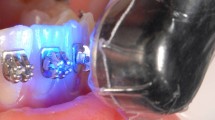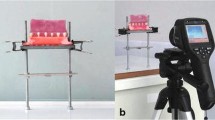Abstract
Objectives
Recent studies have indicated possible thermal damage to pulpal tissue during orthodontic debonding. This study aimed to analyze the thermal loads acting upon dental structures and their transfer to the pulp during orthodontic debonding. Specific goals were to analyze temperature changes in local dental tissues, thermotransduction to the pulp cavity, and the effectiveness of common cooling strategies and of simulated intrapulpal circulation.
Materials and methods
Metal brackets were bonded to five extracted human molars and subsequently removed. While a carbide bur was applied to debond the residual composite from the tooth surface, various cooling strategies (no/air/water cooling) were employed with or without simulated intrapulpal circulation, accompanied by temperature measurements with a thermographic infrared camera on the enamel surface and with measuring probes in the pulp cavity. Appropriate evaluation software was used to calculate the enamel-to-pulp temperature gradients and for statistical analysis.
Results
Significant differences in temperature rise and heat development over time, both on the enamel surfaces and in the pulp cavities were found. The mean temperature rises associated with no/air/water cooling were 90.7/46.6/9.2 °C on the enamel surface versus 9/8/4.6 °C inside the pulp. However, thermotransduction from enamel to pulp remained below 10 % of the surface measurements in all groups. Simulated intrapulpal microcirculation was found to significantly reduce intrapulpal temperature levels.
Conclusion
During debonding of residual bracket adhesives, provided that a carbide bur is properly used, our data indicate a low risk of reaching critical intrapulpal temperatures even in the absence of dedicated cooling and no risk if the instrumentation is accompanied by air or water cooling.
Zusammenfassung
Zielsetzung
Aktuelle Studien weisen auf eine Gefahr einer thermischen Schädigung pulpalen Gewebes während des kieferorthopädischen Debondings hin. Ziel der vorliegenden Studie war es, die Temperaturbelastung dentaler Strukturen und deren Transduktion zur Pulpa hin zu analysieren. Hierbei sollten insbesondere die tatsächliche lokale Temperaturveränderung der beteiligten Gewebe, die stattfindende Temperaturübermittlung zum Pulpenkavum, die Effektivität gebräuchlicher Kühlverfahren und der mögliche Einfluss einer simulierten pulpalen Zirkulation untersucht werden.
Material und Methoden
An 5 extrahierten humanen Molaren wurden Metallbrackets in Schmelz-Ätz-Technik befestigt und anschließend entfernt. Das Debonding des auf dem Zahn verbliebenen Komposits wurde mit einem Hartmetallfinierer in Kombination mit verschiedenen Kühlmethoden (Wasserkühlung, Luftkühlung, keine Kühlung) sowie ohne und mit Installation einer experimentell simulierten Pulpazirkulation Durchgeführt. Temperaturmessungen auf der Schmelzoberfläche erfolgten mittels einer Infrarotkamera, im Pulpenkavum mit Messsonden. Die Kalkulation der Temperaturgradienten sowie die statistische Analyse wurden mit der Software Prism durchgeführt.
Ergebnisse
Die Anwendung unterschiedlicher Kühlverfahren ergab signifikante Unterschiede bezüglich des Temperaturanstiegs und des zeitlichen Verlaufs für die Schmelzoberfläche und das Pulpenkavum. Für den Zahnschmelz wurde eine Temperatursteigerung von durchschnittlich 90,7 °C (ohne Kühlung), 46,6 °C (Luftkühlung) und 9,2 °C (Wasserkühlung) gemessen werden. Sie betrug im Pulpenkavum hingegen ohne Kühlung 9 °C, mit Luftkühlung 8,2 °C und mit Wasserkühlung 4,6 °C. Die Temperaturübertragung vom Zahnschmelz zur Pulpa war unter Verwendung der getesteten Kühlmodalitäten signifikant unterschiedlich und lag in allen Gruppen unter 10 % der extern gemessenen Temperatur. Die Simulation einer Mikrozirkulation reduzierte insbesondere die intrapulpalen Messwerte in signifikantem Maße.
Schlussfolgerungen
Die vorliegenden Daten stellen die thermalen Effekte und deren Weiterleitung von extrakoronal in die Zahnpulpa dreier häufig verwendeter Debondingverfahren gegenüber und vermitteln Einblick in den zeitlichen Verlauf sowie die tatsächliche Belastung dentaler Strukturen. Auf Grundlage der erhobenen Daten kann bei regelrechtem Entfernen des Klebers mit Hartmetallfinierern sowie unter Verwendung einer Luft- oder Wasserkühlung von keinem und bei Unterlassung einer zusätzlichen Kühlung von einem geringen Risiko des Erreichens kritischer pulpaler Temperaturen ausgegangen werden.





Similar content being viewed by others
References
Alomari FA, Al-Habahbeh R, Alsakarna BK (2011) Responses of pulp sensibility tests during orthodontic treatment and retention. Int Endod J 44:635–643
Baysal A, Uysal T, Usumez S (2007) Temperature rise in the pulp chamber during different stripping procedures. Angle Orthod 77:478–482
Bicakci AA, Kocoglu-Altan B, Celik-Ozenci C et al (2010) Histopathologic evaluation of pulpal tissue response to various adhesive cleanup techniques. Am J Orthod Dentofac Orthop 138(12):e1–e7 (discussion 12–3)
Braun A, Kecsmar S, Krause F et al (2015) Effect of simulated pulpal fluid circulation on intrapulpal temperature following irradiation with an Nd:YVO laser. Lasers Med Sci 30:1197–1202
Braun A, Krillke RF, Frentzen M et al (2015) Heat generation caused by ablation of dental hard tissues with an ultrashort pulse laser (USPL) system. Lasers Med Sci 30:475–481
Choi SH, Roulet JF, Heintze SD et al (2014) Influence of cavity preparation, light-curing units, and composite filling on intrapulpal temperature increase in an in vitro tooth model. Oper Dent 39:E195–E205
Cohen SC (1979) Human pulpal response to bleaching procedures on vital teeth. J Endod 5:134–138
Davis S, Gluskin AH, Livingood PM et al (2010) Analysis of temperature rise and the use of coolants in the dissipation of ultrasonic heat buildup during post removal. J Endod 36:1892–1896
Hannig M, Bott B (1999) In-vitro pulp chamber temperature rise during composite resin polymerization with various light-curing sources. Dent Mater 15:275–281
Jost-Brinkmann PG, Radlanski RJ, Artun J et al (1997) Risk of pulp damage due to temperature increase during thermodebonding of ceramic brackets. Eur J Orthod 19:623–628
Jost-Brinkmann PG, Stein H, Miethke RR et al (1992) Histologic investigation of the human pulp after thermodebonding of metal and ceramic brackets. Am J Orthod Dentofac Orthop 102:410–417
Kodonas K, Gogos C, Tziafa C (2009) Effect of simulated pulpal microcirculation on intrachamber temperature changes following application of various curing units on tooth surface. J Dent 37:485–490
Macri RT, de Lima FA, Bachmann L et al (2014) CO laser as auxiliary in the debonding of ceramic brackets. Lasers Med Sci. doi:10.1007/s10103-014-1688-z
Mank S, Steineck M, Brauchli L (2011) Influence of various polishing methods on pulp temperature: an in vitro study. J Orofac Orthop 72:348–357
Matthews B, Andrew D (1995) Microvascular architecture and exchange in teeth. Microcirculation 2:305–313
Mjor IA, Ferrari M (2002) Pulp-dentin biology in restorative dentistry. Part 6: reactions to restorative materials, tooth-restoration interfaces, and adhesive techniques. Quintessence Int 33:35–63
Nalbantgil D, Oztoprak MO, Tozlu M et al (2011) Effects of different application durations of ER:YAG laser on intrapulpal temperature change during debonding. Lasers Med Sci 26:735–740
O’Leary JM, Barnett TP, Parkin TD et al (2013) Pulpar temperature changes during mechanical reduction of equine cheek teeth: comparison of different motorised dental instruments, duration of treatments and use of water cooling. Equine Vet J 45:355–360
Ozturk B, Usumez A, Ozturk AN et al (2004) In vitro assessment of temperature change in the pulp chamber during cavity preparation. J Prosthet Dent 91:436–440
Ramoglu SI, Karamehmetoglu H, Sari T et al (2014) Temperature rise caused in the pulp chamber under simulated intrapulpal microcirculation with different light-curing modes. Angle Orthod. doi:10.2319/030814-164.1
Runnacles P, Arrais CA, Pochapski MT et al (2015) In vivo temperature rise in anesthetized human pulp during exposure to a polywave LED light curing unit. Dent Mater 31:505–513
Saitoh M, Masutani S, Kojima T et al (2004) Thermal properties of dental materials–cavity liner and pulp capping agent. Dent Mater J 23:399–405
Takla PM, Shivapuja PK (1995) Pulpal response in electrothermal debonding. Am J Orthod Dentofac Orthop 108:623–629
Talebi M, Moghimi S, Shafagh M et al (2014) In vitro investigation of heat transfer phenomenon in human immature teeth. J Dent Res Dent Clin Dent Prospects 8:218–224
Uysal T, Eldeniz AU, Usumez S et al (2005) Thermal changes in the pulp chamber during different adhesive clean-up procedures. Angle Orthod 75:220–225
Zach L, Cohen G (1965) Pulp response to externally applied heat. Oral Surg Oral Med Oral Pathol 19:515–530
Acknowledgments
We wish to thank Ms. Beate Schiermeyer for technical support in performing the experiments. The study was supported by University of Bonn Medical School.
Author information
Authors and Affiliations
Corresponding author
Ethics declarations
Conflict of interest
P. Kley, M. Frentzen, K. Küpper, A. Braun, S. Kecsmar, A. Jäger, and Michael Wolf state that there are no conflicts of interest.
The accompanying manuscript does not include studies on humans or animals.
Additional information
PD Dr. med. dent. Michael Wolf.
P. Kley and M. Wolf contributed equally to the manuscript.
Rights and permissions
About this article
Cite this article
Kley, P., Frentzen, M., Küpper, K. et al. Thermotransduction and heat stress in dental structures during orthodontic debonding. J Orofac Orthop 77, 185–193 (2016). https://doi.org/10.1007/s00056-016-0023-7
Received:
Accepted:
Published:
Issue Date:
DOI: https://doi.org/10.1007/s00056-016-0023-7




